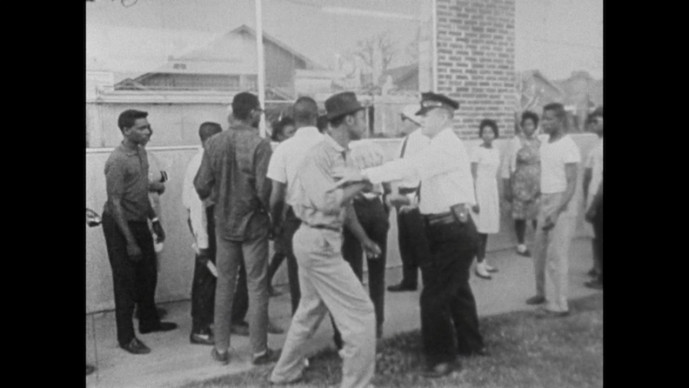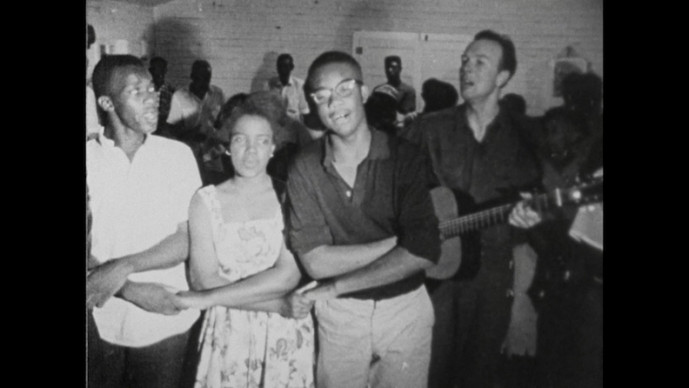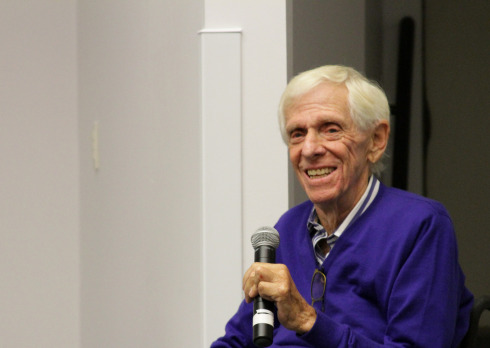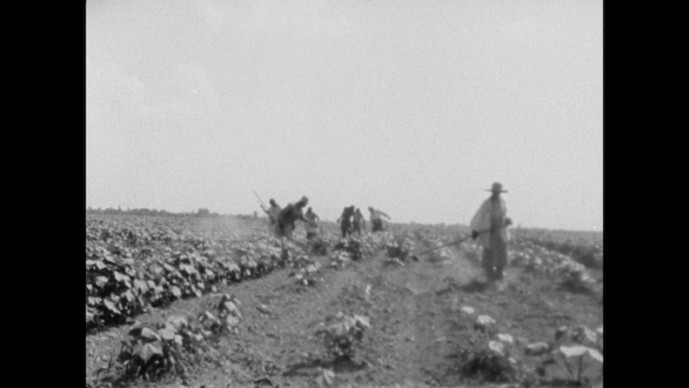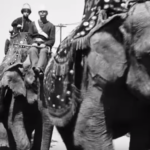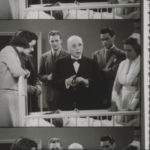Washington University Preserves Rare Civil Rights Documentary
The Washington University Libraries’ Film & Media Archive has completed the preservation and digitization of The Streets of Greenwood, a rare civil-rights documentary film from 1963, and has made it freely available, online.
n
The Archive completed the work with a Basic Preservation Grant it received in last year’s [2016] round of funding from the National Film Preservation Foundation. One purpose of the grants is to allow archives to make noteworthy films publicly available.
The Archive used its NFPF award to preserve both the documentary film and two reels of outtakes, which include unreleased silent footage of Seeger, civil rights leader Robert Moses, musician Theodore Bikel, and a young Bob Dylan. (Reel one; reel two.)
In its brief 20 minutes, The Streets of Greenwood records voter-registration efforts that the Student Nonviolent Coordinating Committee (SNCC) organized in Greenwood in the summer of 1963, during a particularly dangerous phase of the civil-rights movement, just one month before civil-rights leaders would launch the historic March on Washington.
The Streets of Greenwood won the gold medal at the San Francisco Film Festival, and would lead to Willis’s directing, producing, or writing 16 more documentaries and several television series. His acclaimed documentaries, which he said he made to present “unheard voices, unserved voices,” include Lay My Burden Down (1966), Appalachia: Rich Land, Poor People (1968), Hard Times in the Country (1969), and Paul Jacobs and the Nuclear Gang (1979), a damning multi-award-winning exposé of government suppression of the health hazards of exposure to radiation from Nevada nuclear testing during the 1950s and 1960s. Willis also became a co-founder of Link TV, a Direct Broadcast Satellite channel that goes to more than 34 million American homes.
In 2014, Washington University’s Film & Media Archive acquired the Jack Willis Collection.
Willis produced The Streets of Greenwood with John Reavis and Fred Wardenburg, with cameraman Ed Emshwiller as cameraman (using singer Pete Seeger’s Auricon camera). Willis undertook the project after he and James Forman, a visionary activist and early key member of SNCC, fell into conversation with Seeger about SNCC’s efforts to get black Mississippians onto electoral rolls. SNCC had been organizing in difficult circumstances in and around Greenwood. Police had responded to their peaceful protests with arrests and dog attacks. One leading civil-rights activist, Medgar Evers, was murdered in June 1963; the killer, Byron de La Beckwith, a white supremacist and Ku Klux Klan member who lived in Greenwood, would not be convicted until 1994 because in 1964 two juries declined to find him guilty.
n
SNCC activists called a July 1963 rally and concert. Performers who agreed to appear included Bob Dylan along with Seeger and another figure in the “protest song” movement, Theodore Bikel, who in 1959 had started the Newport Folk Festival in the northeast state of Rhode Island, five years after the city’s annual jazz festival had begun. (Emshwiller captured footage of Bob Dylan singing “Only a Pawn in Their Game,” which is about the assassination of Medgar Evers, at a rally in support of the voter-registration campaign, but it did not appear in The Streets of Greenwood; D.A. Pennebaker used it in his 1967 Dylan documentary, Dont Look Back.)
Streets of Greenwood includes unsettling interviews in which segregationists including the town’s mayor C. E. Sampson, a tenant farmer, and white supremacists at a rally of their own vent their gall at mounting local resistance to the political and social status quo. In many respects, the footage serves to illustrate thinking of the time. Language in it often reflects white-activist paternalism – talk of “the new Negro discontent.” At other moments, the film demonstrates the staggering condescension of the white land-owners and townspeople: the self-congratulating “good white folks” who speak of their affection for non-militant black neighbors, and the true supremacist bigots who spew blood-curdling venom.
In stark contrast, black citizens tell of the oppressive nature of the share-cropping system of agriculture with which Southern land owners had sought to extend their control of economic production after the Civil War and abolition of slavery a century earlier.
Interspersed is footage of performances by Seeger joining activists in singing protest anthems of the day, including “Keep Your Eyes on the Prize” and “We Shall Overcome.” The outtake material includes additional sequences of Seeger and Bikel, as well as as-yet unreleased footage from the freedom rally: protesters gathering, singing, and linking hands (https://vimeo.com/220968246; https://vimeo.com/220968723).
The Streets of Greenwood has great historical significance because the voter registration campaign in the town was “one of the great unsung turning points” in the struggle for civil rights, and the filmmakers captured it with “rich visuals, ear-to-the-ground viewpoint, and astute narration,” says Washington University sociologist David Cunningham. “From protest footage, to police dogs, to Pete Seeger’s cotton-field performance, The Streets of Greenwood packs a tremendous amount of valuable material into its compact 20 minutes.”
The film is relative obscure by comparison with some other films documenting the civil-rights era. But its enormous historical significance and educational value lie in its close-up view of the efforts of activists to register African American voters in Greenwood, Mississippi. Over the years, Willis has often licensed material from it, most recently for “The Voting Rights Act at 50,” an event held by the Smithsonian Institution and the NAACP in July 2015. It has been used in a variety of other films about the civil-rights era, including works by noted African American filmmakers Stanley Nelson and Sam Pollard.
Willis was inspired in his direction by the handheld-camera approach of the Drew Unit. That was a group of cameramen and correspondents whom Life magazine photojournalist and editor Robert Drew had assembled in the 1950s — including the later high-profile filmmakers Richard Leacock, D.A. Pennebaker, and Albert Maysles — to produce films that revolutionized documentary filmmaking in the United States by introducing the cinéma vérité observational approach to capturing everyday life.
“The film and its outtakes give a rare window into grassroots civil rights action that will be of great use to students, scholars, and media makers,” says Brian Woodman, curator of the Film & Media Archive, which is a center for scholarship, teaching, and learning that focuses on America’s great political and social movements, with a particular emphasis on the African-American experience.
Archivists at the St. Louis, Missouri facility made copies of the prints’ video and audio components and composite prints that now can serve as the basis for distributable prints as well as a high-definition digital preservation file and Blu-Ray access copies.
In its 2016 round of preservation grants, NFPF provided funding to 39 institutions to restore 64 films and make them publicly accessible. In 1996, the U.S. Congress created NFPF to help save America’s film heritage. The Foundation receives federal money through the U.S. Library of Congress. In its Basic Preservation Grant program, it has to date provided support to 309 institutions and saved almost 2,350 films. A catalog of the films is online.
— MIAN & Washington U release
Previous Post: National Film Preservation Foundation Awards 36 Preservation Grants
Next Post: Life in a Wisconsin Convent in 1958

